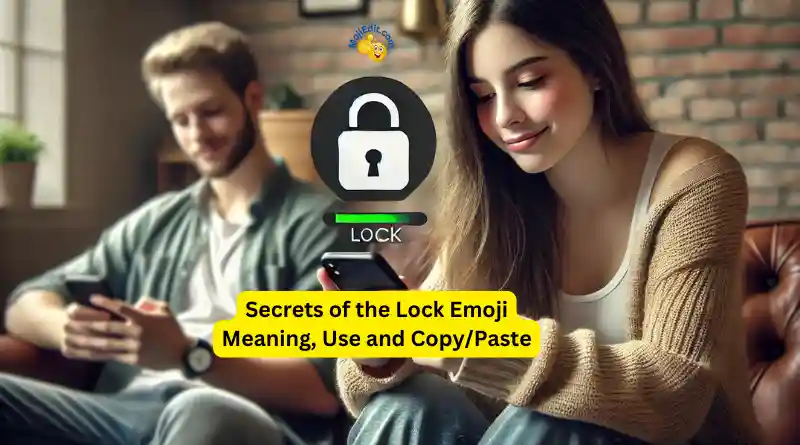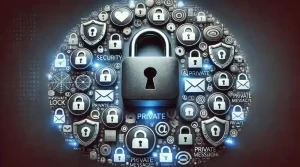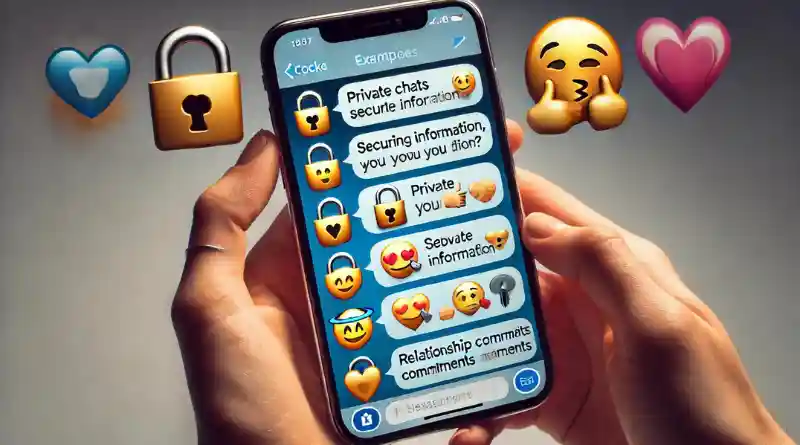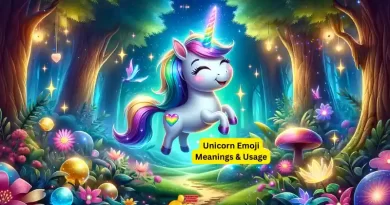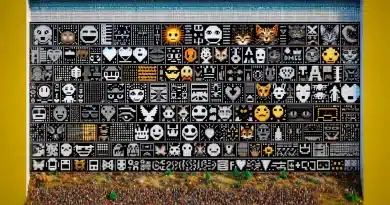El Emoji del Candado 🔒: Del Unicode a los mensajes de texto: todo lo que necesitas saber
Introduction: 🔒 What’s Up with the Lock Emoji?
🔒 An Overview
Hey there! Today we’re diving into the fascinating world of the lock emoji 🔒. This little icon might seem simple, but it carries a lot of weight in our digital conversations. The lock emoji represents security, privacy, and confidentiality. It’s a universal symbol for keeping things safe and secure, whether it’s your personal data or a private message to a friend. It is also often paired with our friend the key emoji.
Unicode introduced the lock emoji in version 6.0 back in 2010, and it became part of Emoji 1.0 in 2015. You’ll often see it in contexts related to online security, private accounts, and anything that needs to be “locked down.” So, let’s unlock all the details about this emoji!
Key Takeaways: 🌟 Quick Facts about the Lock Emoji
🚀 Emoji Essentials
Here’s a quick overview of the key sections about the lock emoji 🔒 you’ll find in this article:
- Copiar y pegar: Learn how to effortlessly copy and paste the lock emoji on various devices and platforms.
- Significado: Discover the symbolism and contextual meanings of the lock emoji, representing security, privacy, and confidentiality.
- Historia (Unicode): Explore the history and evolution of the lock emoji, from its introduction in Unicode 6.0 to its design variations across platforms.
- Julia’s Emoji Examples: Get inspired by some of my creative ways to use the lock emoji in conversations, emphasizing security and commitment.
- Ejemplos de combos: Check out popular and creative emoji combinations with the lock emoji, such as 🔒🔑 (secure access) and 🔒❤️ (committed relationship).
- Emojis relacionados: Learn about other emojis that complement the lock emoji, like the unlocked emoji (🔓) and key emoji (🔑).
- Diferencias culturales: Understand how different cultures perceive and use the lock emoji, from security and privacy in the West to commitment and loyalty in the East.
- Conclusión: Recap the main points and Julia’s final thoughts on the significance and versatility of the lock emoji.
- PREGUNTAS FRECUENTES – 10 Questions and Answers: Find answers to the most common questions about the lock emoji, including its meanings, uses, and popular combinations.
Copy and Paste: 📋 How to Copy and Paste the Lock Emoji Like a Pro
🖥️ Platform-Specific Steps
Copying and pasting the lock emoji 🔒 can be super easy if you know the right steps for your device. Here’s how to do it across different platforms:
iOS and Android:
- Open the Emoji Keyboard: Tap on the emoji icon on your keyboard.
- Search for the Lock Emoji: You’ll usually find it in the objects or symbols section.
- Tap to Insert: Just tap on the emoji to insert it into your text.
Windows:
- Press Windows + Period (.): This opens the emoji panel.
- Search and Click: Find the lock emoji and click on it to insert.
Mac:
- Press Control + Command + Space: This opens the emoji and symbol viewer.
- Find and Click: Locate the lock emoji and click to insert.
Copiar y pegar: If you prefer the copy-paste method, here’s how you can do it:
- Copy this emoji: 🔒
- Paste it: Use Ctrl+V (Windows) or Command+V (Mac) to paste it wherever you want.
Mojiedit:
Want to add a touch of security to your messages or posts? You can easily copy the lock emoji 🔒 and paste it wherever you need a symbol of privacy or protection. Just follow these simple steps:
- Click the “Copy” button below to copy the lock emoji to your clipboard.
Emoji Copied! 🔒
- Ve al lugar donde quieras utilizar el emoji y haz clic con el botón derecho del ratón en el campo de texto.
- Elige "Pegar" en el menú contextual, o simplemente utiliza el atajo de teclado Ctrl + V (Windows) o Cmd + V (Mac) para pegar el emoji.
And voilà! You’re all set to add a layer of security to your digital conversations.
These steps should help you add a layer of security to your messages with ease!
Meaning: 🤔 What Does the Lock Emoji Mean?
🔐 General Symbolism
The lock emoji 🔒 symbolizes security, privacy, and confidentiality. It’s a versatile icon represents the protection of information, restricted access, and safety in various contexts. Whether you’re talking about a secure website, a private account, or confidential matters, this emoji is the perfect symbol to convey these themes.
💬 Contextual Meanings
Depending on the situation, the lock emoji can take on different meanings. Here are some common interpretations:
- Security and Privacy: It often highlights the importance of keeping something safe or private, like a secure website or a private message.
- Commitment and Loyalty: In relationships, it can symbolize commitment and exclusivity, indicating a secure and strong bond.
- Mystery and Intrigue: Sometimes, it’s used to add an element of mystery or secrecy to a conversation, sparking curiosity and interest.
Example Conversations:
- “Make sure to secure your account 🔒.”
- “Our love is strong and secure, nothing can break us 🔒❤️.”
- “I have a secret to tell you, but it’s locked between us 🔒.”
Using the lock emoji in these ways can add depth and clarity to your digital conversations, making your messages more engaging and precise
History (Unicode): 📜 The Evolution of the Lock Emoji
🔤 From Unicode to Your Keyboard
The🔒emoji has an interesting history, packed with digital evolution and standardization. It was introduced as part of Unicode 6.0 in October 2010 and was included in Emoji 1.0 in 2015. Unicode is a standard that assigns a unique code to every character and emoji, ensuring they appear consistently across all platforms and devices.
It is categorized under the “Miscellaneous Symbols and Pictographs” block and its Unicode codepoint is U+1F512. Its design represents a closed padlock, symbolizing security and privacy. Over the years, this emoji has become a staple for indicating secured and private information in digital communication.
🔄 Design Changes Over Time
While the core design of the lock emoji remains consistent, each platform adds its unique touch. Here’s how it looks across different platforms:
- Manzana: A detailed gold padlock with a silver shackle.
- Google: A simpler design featuring a gold padlock with a silver shackle.
- Microsoft: A stylized, sleek design of a padlock.
Despite these variations, the lock emoji universally symbolizes security and protection, making it a crucial part of our digital vocabulary
Emoji Examples: 😍 Fun and Creative Ways to Use the Lock Emoji
🎉 My Favorite Uses for the Lock Emoji
Hey there, emoji enthusiasts! Let’s dive into some fun and creative ways to use the lock emoji 🔒 in your conversations. Whether you’re talking about security, sharing secrets, or expressing commitment, the lock emoji can add a whole new layer of meaning to your messages.
1. Secure Conversations:
- Private Chats: “This info is just between us 🔒.”
- Online Security: “Always use strong passwords to protect your accounts 🔒💻.”
2. Relationship Goals:
- Commitment: “Our relationship is locked and secure 🔒❤️.”
- Exclusivity: “You’ve got the key to my heart 🔒🔑.”
3. Adding Mystery:
- Secrets: “I have a secret to tell you, but it’s locked between us 🔒.”
- Intrigue: “Something exciting is coming up, but I can’t share the details just yet 🔒🤫.”
Combo Examples: 🌟 Awesome Emoji Combos with the Lock Emoji
🔥 Popular Pairings
Combinar emojis can make your messages much more engaging and expressive. The lock emoji 🔒 pairs beautifully with other emojis to convey deeper meanings. Here are some popular combinations:
1. 🔒🔑 (Lock and Key)
- Significado: Represents secure access or a hidden secret.
- Example Usage: “My journal is locked 🔒🔑, only I have the key!”
2. 🔒❤️ (Lock and Emoji de corazón rojo)
- Significado: Signifies a strong, committed relationship.
- Example Usage: “Our love is unbreakable 🔒❤️.”
3. 🔒📄 (Lock and Document)
- Significado: Indicates confidential information or secure documents.
- Example Usage: “Make sure to secure all your important files 🔒📄.”
4. 🔒💬 (Lock and Speech Bubble)
- Significado: Perfect for private conversations or sensitive topics.
- Example Usage: “This chat is private 🔒💬, please don’t share it.”
5. 🔒📦 (Lock and Package)
- Significado: Ideal for discussing secure deliveries or confidential packages.
- Example Usage: “The package is securely delivered 🔒📦.”
🔍 Hidden Meanings
Each combination carries unique nuances that can enhance your communication. Let’s break down some of the hidden meanings:
🔒🔑 (Secure Access):
- This combo symbolizes something that is securely locked away or only accessible to certain people. It’s great for highlighting privacy and security in a tangible way.
🔒❤️ (Committed Relationship):
- This combo is perfect for expressing a secure and committed relationship. It shows that your bond is strong and protected.
🔒📄 (Confidential Information):
- Use this to emphasize that certain information is sensitive and needs to be kept secure. It’s great for discussing private documents or data.
Combining these emojis adds depth and creativity to your messages, making them more fun and expressive. Give it a try and see how these combos can enhance your digital conversations!
Related Emojis: 🔑 Emojis That Go Hand-in-Hand with the Lock Emoji
🔓 Similar Lock Emojis
The 🔒 emoji is part of a family of lock-related emojis that represent various aspects of security, privacy, and access. Here’s a look at some of its close relatives:
- 🔓 Unlocked: This emoji represents something that has been unlocked or is accessible. It indicates that something is open and no longer restricted.
- 🔏 Locked with Pen: Symbolizes secure or confidential writing. It’s often used in contexts involving digital signatures or encrypted messages.
- 🔐 Locked with Key: Depicts a padlock with a key, emphasizing the concept of secure access. It commonly signifies something is protected by a key or password.
Each of these emojis has its unique symbolism and use cases, making them versatile for various contexts involving security and privacy.
🤝 Perfect Pairings
Here are some emojis that perfectly complement the lock emoji:
-
🔑 Key: Represents the tool used to unlock something, adding a sense of access. This pairing is perfect for emphasizing secure access or a hidden secret.
- Example Usage: “Our secrets are safe 🔒🔑.”
-
🖥 Computer: Emphasizes digital security and the importance of keeping your online presence safe.
- Example Usage: “Always use strong passwords to protect your accounts 🔒🖥.”
-
📄 Document: Used to highlight confidential or secure documents, emphasizing the need for privacy.
- Example Usage: “Make sure to secure all your important files 🔒📄.”
These pairings can make your messages more vibrant and expressive, adding depth to your digital conversations.
🔧 Thematic Emojis
In addition to the related lock emojis, there are several other emojis that fit well within the theme of security and privacy:
- 🛡️ Shield: Symbolizes protection and security.
- 🔗 Link: Represents a connection or access point.
- ⛓️ Chains: Emphasizes something that is strongly secured or locked down.
Combining these thematic emojis with the lock emoji can create powerful and expressive messages that convey a strong sense of security and protection.
Cultural Differences: 🌏 How Different Cultures See the Lock Emoji
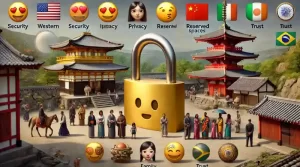
🇺🇸 Western Perspectives
In Western cultures, the lock emoji generally symbolizes security, privacy, and confidentiality. It emphasizes the importance of protecting personal information and ensuring secure communications. Ejemplos de uso:
- “Make sure your account is secure 🔒.”
- “This message is private, please don’t share it 🔒.”
🇯🇵 Japanese Perspectives
In Japan, the lock emoji can symbolize privacy and confidentiality, similar to its use in Western cultures. Additionally, it represents something that is reserved or fully booked, indicating exclusivity and privacy. Ejemplos de uso:
- “This room is reserved 🔒.”
- “Please respect my privacy 🔒.”
🇮🇹 Italian Perspectives
Italy, people might interpret the lock emoji as “don’t disturb” or “occupied.” It implies that someone is not interested or that a particular place or thing is currently unavailable. Ejemplos de uso:
- “Sorry, I’m not interested 🔒.”
- “This seat is taken 🔒.”
🇨🇳 Chinese Perspectives
In Chinese culture, the lock emoji often symbolizes security and protection, particularly in the context of family and personal spaces. It is associated with preserving the integrity of family secrets and values. Ejemplos de uso:
- “Keep our family traditions secure 🔒.”
- “This information is for family only 🔒.”
🇮🇳 Indian Perspectives
In India, the lock emoji can symbolize trust and security, often used in the context of personal and financial security. It is also a symbol of reliability and safeguarding personal space. Ejemplos de uso:
- “Your personal data is secure with us 🔒.”
- “Please keep this confidential 🔒.”
🌍 African Perspectives
In various African cultures, the lock emoji may symbolize the safeguarding of cultural heritage and secrets. It signifies the protection of community values and traditions. Ejemplos de uso:
- “Our heritage is preserved 🔒.”
- “This information is sacred 🔒.”
Cuadro sinóptico
| Cultura/Región | Simbolismo/Significado | Ejemplos de uso |
|---|---|---|
| 🇺🇸 Western Perspectives | Security, privacy, confidentiality | “Make sure your account is secure 🔒.” |
| 🇯🇵 Japanese Perspectives | Privacy, confidentiality, reserved | “This room is reserved 🔒.” |
| 🇮🇹 Italian Perspectives | Don’t disturb, occupied | “Sorry, I’m not interested 🔒.” |
| 🇨🇳 Chinese Perspectives | Security, protection, family integrity | “Keep our family traditions secure 🔒.” |
| 🇮🇳 Indian Perspectives | Trust, security, reliability | “Your personal data is secure with us 🔒.” |
| 🌍 African Perspectives | Safeguarding heritage, cultural values | “Our heritage is preserved 🔒.” |
Understanding these cultural differences can help you use the lock emoji more effectively and appropriately in your digital communications.
Wrap Up (Conclusion): 🌟 Wrapping It Up: Key Points and Final Thoughts
📌 Recap of Main Points
Wow, we’ve covered a lot about the 🔒 emoji ! Let’s quickly recap the main points:
- Copiar y pegar: You can easily copy and paste the lock emoji on various devices, enhancing your digital security communications.
- Significado: The lock emoji symbolizes security, privacy, and confidentiality, making it perfect for discussing secure or private matters.
- Historia (Unicode): Introduced in Unicode 6.0 in 2010, the lock emoji has remained a consistent symbol of protection across different platforms.
- Julia’s Emoji Examples: Creative uses of the lock emoji can include emphasizing private conversations, expressing commitment, and adding mystery.
- Ejemplos de combos: Popular combinations like 🔒🔑 (lock and key) and 🔒❤️ (lock and heart) add depth and meaning to your messages.
- Emojis relacionados: Emojis like 🔓 (unlocked), 🔏 (locked with pen), and 🔐 (locked with key) complement the lock emoji perfectly.
- Diferencias culturales: Different cultures interpret the lock emoji in unique ways, from security and privacy in the West to commitment and exclusivity in Japan.
- FAQ – 10 Questions and Answers: Address common questions about the lock emoji, its uses, and meanings.
💭 My Final Thoughts
I hope you enjoyed this deep dive into the world of the lock emoji 🔒! This small symbol carries so much meaning and is used in many different ways. Whether you’re emphasizing security in your messages, adding a layer of privacy, or expressing a strong commitment, the lock emoji is a versatile and powerful tool. Keep exploring and using emojis to make your digital conversations more expressive and fun!
Preguntas y respuestas frecuentes
The lock emoji symbolizes security, privacy, and confidentiality. It’s often used to indicate that something is protected, private, or off-limits.
You can use it to emphasize secure communications, private information, or restricted access. For example, “Make sure your account is secure 🔒.”
Popular combinations include 🔒🔑 (lock and key) for secure access, and 🔒❤️ (lock and heart) to signify a committed relationship.
Interpretations can vary. In Western cultures, it often symbolizes security and privacy, Japan, it can also mean something is reserved or exclusive. Finally, in Italy, it might imply “don’t disturb” or “occupied.”
The lock emoji was introduced as part of Unicode 6.0 in 2010 and included in Emoji 1.0 in 2015.

